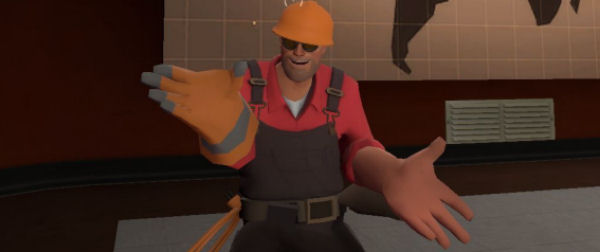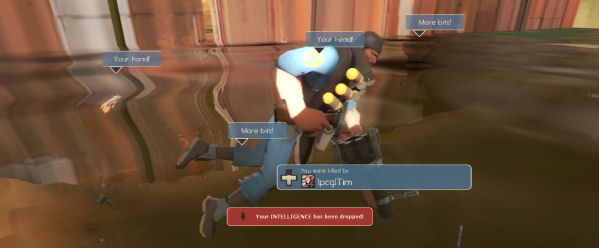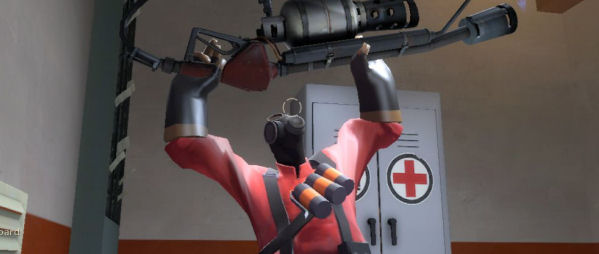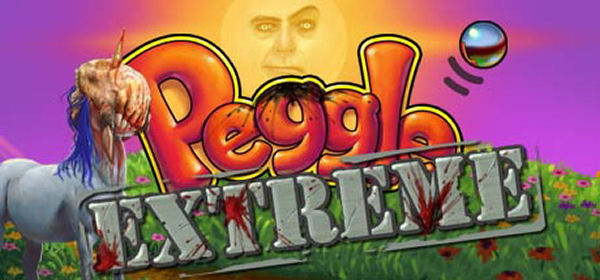RPS Team Fortress 2 Interview - Part 2
Welcome back to Rock, Paper, Shotgun's exclusive interview with Team Fortress 2 developers, Robin Walker and Charlie Brown. (Here's Part One if you missed it.) This time we get down to the finer details of the classes on offer, and talk about their evolution, as well as discussing Valve's other great obsession, PopCap's Peggle. But first we talked about the remarkable part humour had to play in TF2's development.
RPS: I want to ask about the role of humour in the game. You watch the promo movies, and they’re really hilarious, but you think: how can those possibly carry over into a multiplayer game where there’s people playing everyone? And yet somehow it has.
Robin Walker: It actually came about the other way.
Charlie Brown: When we sat down to start work on this, we realised there are a lot of funny moments in multiplayer games. In Counter-Strike and Day of Defeat, these are realistic games that aren’t intended to be humorous, but you have ragdolls, you have people fighting with non-realistic tactics...
RW: And people! Put people in a room with guns and tell them to behave, and there’s no repercussions and there’s no consequences… [Laughs].
CB: Funny stuff just happens. So when we started, we knew what kind of weapons we wanted, we knew the physics, we knew we had really fast movements speeds and not all our weapons were realistic, and so it was pretty easy to see during testing that these funny moments happened way more frequently than they did in our other games. That was one of the reasons we chose this art style in the first place. We said, let’s just embrace the exaggerated funny things that happen. We used that to our advantage.
RW: It led to a lot of ideas that I don’t think we would have had. One of my favourites is the gib call-outs, where in the Death Cam, if there are little pieces of you on screen, they’ll get little labels.
CB: My personal favourite would be the Spy masks. We never would have done that in something serious. The humour solved a bunch of problems.
RW: The earliest version of TF2 that you guys never got to play was this ultra-realistic… it looked a lot like Counter-Strike to a large degree. We wanted to do all these things, but realism fought us every step of the way. In a realistic game it’s hard to justify why everything isn’t just a bullet or an explosive, because at the end of the day, that’s what kills people in the real world. Almost anything you invent other than that will be worse, not better. We wanted to build weapons with some travel time to them. It’s a worse weapon in a realistic sense, but usage-wise it gives some interesting characteristics. In a realistic game you’re constantly asking yourself why someone has that gun.
CB: And we have things that look like guns but aren’t.
RW: Heh, yeah. This is a gun! Shoot your friends with it!
CB: And it will make them stronger.
RW: So the point I was trying to make was that we spent some time squirming under this art direction that we’d chosen too early. Later, when we started thinking about humour, we had a lot of fun with being free. We realised we could do that thing that we’d joked it would be fun to do. Well guess what? Now we can do it. Let’s do it!
RPS: Do you have any examples of what those things might have been?
RW: Well, the gib call-outs was one.
CB: The Spy masks. The air-walk when the Soldier jumps in the air.
RW: And all of the comments stuff. The voice system in Half-Life 2 that governs how characters talk – we realised it had a huge amount of freedom. The underlying system has a lot of power that in some ways really aren’t apparently in Half-Life 2. It’s built for really dynamic places where the state of the world is really unknown. It’s a really good system for determining what’s the best option. There might be ten different options for saying, “I’m reloading”, for all different circumstances. The system’s really good at saying, this is the one that’s most appropriate right now. And so when we started thinking about the facial animation and applying that to multiplayer, that got us really excited because that’s exactly what multiplayer space is. A really dynamic place. So the system can choose, here’s a really good line for you to say after you’ve killed that guy. Because he’s the sixth guy you’ve killed in the last thirty seconds, and you’re dominating him, and you’re a Heavy, and he’s a Scout, so it’s time to yell, X. So we’re able to fill the game will all these fun phrases. To a level where even today as we play, every now and then we hear a line we’ve never heard, after months.
CB: It’s also incredibly useful. We’ve had a few play-testers who weren’t really aware of the game, and the Engineers building up his…
RW: “Building a teleporter!”
CB: And we’ve got this person going…
RW: “Hey, it’s a teleporter.”
CB: And they figured out what teleporters were at that point.
RW: And the Spy mask thing. The Spy mask is one of the best examples to back all the way up to what we were talking about earlier with acceptability. One of the things we’ve learned over the years is we’ve grown a healthy hatred of outside-the-game solutions to problems that are really about art direction, or about…
CB: Presentation.
RW: So we have a problem. I want to show you what class your Spy on your team is. And we want him to look like a Spy, because we know through play-testing that he’s got to look like a friendly spy all the time or it’s incredibly confusing to new players. So the first thing we think of is, put a radical above the dude’s head that’s an image of the Scout or something. And we hate that because the more you fill the game with those sorts of things, the more people look at them and not the characters. Everything that’s most important in the world should be the characters. So you shouldn’t check someone’s team by looking at a radical above their head. You should look at the character and that should tell you. We felt that if we kept to that you’d be looking at the world first, and your HUD second. So just as a test we put the radical over the Spy’s head, which we all hated but we didn’t have a better idea at the time. And right off the bat, play-testers had trouble with it. If you’re a new player and you see a Scout above the head of a guy, it doesn’t tell you what it is. It just says, that guy’s got a floaty Scout above his head. We said, we can’t do this, whatever we do it has to be on the character. Within a day or two we came up with the Spy masks. Internally we keep looking back on that moment as one of those eureka moments that validates, a) when we push ourselves to not take the easy route we often get better solutions, and b) that wholehearted consistency to keeping information on the character is making us stay honest. And it works really well. We get new players who don’t even know what the Spy can do, and they look at that character and he’s wearing that paper mask, and they think, “Well, I guess he’s like disguised as that guy.”
RPS: So, do you guys have favourite characters?
RW: I think most of us here play three or four classes each.
CB: I could say that I’m not very good at the Scout, and I’m not as good as the Spy as I’d like to be.
RW: I’m probably best between the Scout and the Soldier. I have a penchant for playing anything that trades speed for fire power.
One of the things that we’re happiest about is that TF is more about versatility. It’s been really fun watching the online communities go through a micro version of the passage we’ve all gone through here. It’s like, “Oh, they’re all at the Heavy/Medic phase! They’re soon going to get to the, Holy crap, Snipers kick the crap out of that phase!” They’re saying, “This is too powerful,” and we’re thinking, “Well next week you’re going to find that this destroys that.” It’s really fun to see.
CB: But it’s still an effective combo. There’s no complete counter for it.
RPS: Any less favourite characters?
RW: I don’t play a lot of Demoman, but I get destroyed by it a lot. There’s some really good Demoman players in this company.
CB: Mine’s the Heavy. Not for any lack of power, I just like to move quickly.
RW: I like the Heavy a lot. If only for his singing taunts. [He starts loudly singing] Dun dun dun daahh dun!
CB: Usually I play the Medic or the Engineer, because personality-wise I tend toward the support characters, but on my more aggressive days I really do like the Pyro or the Soldier.
RW: So much of the class interactions are a result of the best choices on your server. If you’re a hopeless optimiser like I am, then as the numbers of the Heavies and Medics increases, the value of Snipers increases, so I’ll often switches classes after about five minutes once I’ve seen what the enemy make-up is, or I can see what they’re trying to do. That’s why it’s been really fun going out on public servers with an over-abundance of Spies these days. Internally we all have a fairly effective Spy radar in our heads, so you get to have a lot of fun. I’ve had friends message me with Steam Community and say, “There’s this Spy that’s causing us a lot of trouble.” So I’ll go in the game and dominate the Spy pretty easily, because at this point most of the Spies are still using pretty simple tactics. They haven’t been forced to learn the harder tactics the Spy uses, and as people get more and more experienced dealing with Spies, they’re going to be forced to do that. Right now the population of Spies is such that you can have a blast just running out there as a Pyro. That back and forth is an interesting one, and I don’t think it ever stops. There’s always going to be a flavour of the month. And that’s always a response to what the flavour of the last month was.
RPS: Would you agree with my theory that people who play the Medic have a Messianic complex?
CB: [Laughs] Are you telling me or asking me?
RW: It was very interesting to see how much more people liked the Medic after we put in some of the automatic responses. So when you charge any class to a large amount, they automatically thank the Medic, and that immediately meant people playing the Medic were happier. I’m sure most of them know it’s automatic, and you can thank them anyway, but just being told by the game, “you’re doing good”, works. If you asked us some of the things we’re proudest of in the game, Medic would be high up there. We always wanted to build a support class where when you chose him you didn’t feel like you were having to step down in any way, that you were making a secondary choice, that you were somehow giving up a part of your own success to be that person. And similarly, you weren’t relegating your gameplay to some non-fun thing, where you get to stand behind the combat around the corner, and never come around. We wanted to build a Medic where there was a lot of skill to it, where there was a big difference from beginner Medics and experienced Medics, and that the best Medics were the ones who were in combat, able to stay alive under a huge amount of fire – the ones who were game winners. The simple mantra is, if there’s a Medic there he needs to have as big an impact on the game as if he were a Soldier or a Heavy. One of the moments when we thought we were on the right track was when we had a couple of our guys who were some of our best FPS hardcore players, transition to playing Medic almost exclusively.
RPS: Presumably the Medic’s needle gun would be another of those things that wouldn’t have been possible without the humour?
CB: The needle gun is… a bit different.
RW: We still haven’t got it so the needles stick in the body, and we really want to recreate that Indiana Jones pin-cushion guy. So you come around the corner and there’s a corpse with a hundred needles in his back. They stick in the world right now, but not other people.
RPS: Tell me about Peggle.
CB: It’s awesome?
RW: We play a lot of Peggle? I think the funniest thing was when we shipped the Steam Community beta, and we’d made the Valve group, I went to the group and I saw, top most played game, 170 hours of Peggle in the last week. And I thought, wow, what a bunch of hardcore gamers we are!
CB: Every time someone will go to compile, Peggle’s there. So you’re sitting there coding, and with Steam Community on, while you’re working you’ll see, “Blah blah playing Peggle,” and, “Blah blah playing Peggle,”…
RPS: And this led to the Valve Peggle?
RW: Yeah, Eric’s local, so that was cool. We could have those guys come around and work on the site for a while, and have some of our artists help. That was a classic example of [he chuckles], there’s no real strategic business decisions going on. We want more Peggle! You can GIVE us more Peggle! Put that in the box, how does that sound?
RPS: Did you have any inkling of this when PopCap went onto Steam?
CB: Well, we all started by playing Insaniquarium.
RW: And we’ve got at least one guy who claimed to be the world’s best Bookworm player. Just very matter-of-fact. He can tell you the top-scoring words he’s ever done. I guess there’s some fixed order in which the original Bookworm dropped its letters, and he knows the exact order of every letter that’s going to arrive, so he can start planning his moves. He took it to the ridiculous level. So we were all really excited about Bookworm Adventures.
RPS: I love Bookworm Adventures. I prefer it to Peggle.
RW: Well... Well, I think you’re insane.
CB: I’m going to walk out the interview now.
RW: My wife likes Bookworm Adventures. But she doesn’t like Peggle, for some reason. So that’s why we had to get divorced… [laughs]. I’m a dead man.
A huge thanks to Robin and Charlie for the time they gave us, and the depth they were willing to go into. In Robin's defense, he's still married to his Bookworm-loving wife, and hopes to stay that way, despite our printing his comments. Don't forget to enter our Valve Compo, for a chance to win a copy of Half-Life 2: Raising The Bar, signed by Gabe Newell. And lest thee never ignore our commentary on TF2's classes, in our Go Team! ultromegafeature.






